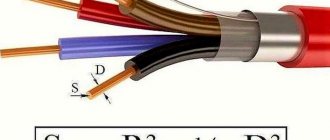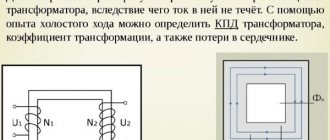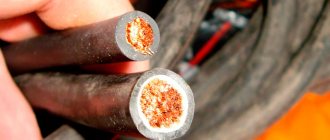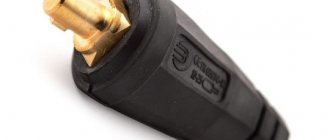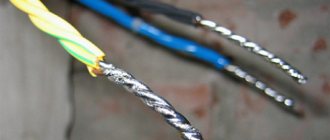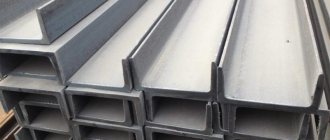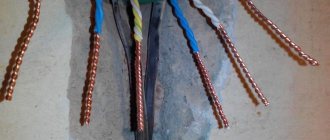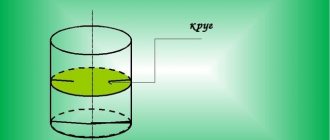A cross section is a figure formed by the intersection of an oblong body with an imaginary plane, located perpendicular to each other, i.e. when the body is cut strictly across its length.
The section can have a simple or complex shape, or be composite.
The area and dimensions (length and width) of the cross section are equal to the corresponding dimensions of this figure.
General information about cable and wire
When working with conductors, it is necessary to understand their designation.
There are wires and cables that differ from each other in their internal structure and technical characteristics. However, many people often confuse these concepts. A wire is a conductor that has in its design one wire or a group of wires woven together and a thin common insulating layer. A cable is a core or a group of cores that has both its own insulation and a common insulating layer (sheath). Each type of conductor will have its own methods for determining cross sections, which are almost similar.
Conductor materials
The amount of energy that a conductor transmits depends on a number of factors, the main one of which is the material of the current-carrying conductors. The following non-ferrous metals can be used as the core material of wires and cables:
- Aluminum. Cheap and lightweight conductors, which is their advantage. They are characterized by such negative qualities as low electrical conductivity, a tendency to mechanical damage, high transient electrical resistance of oxidized surfaces;
- Copper. The most popular conductors, which have a high cost compared to other options. However, they are characterized by low electrical and transition resistance at the contacts, fairly high elasticity and strength, and ease of soldering and welding;
- Aluminum copper. Cable products with aluminum cores coated with copper. They are characterized by slightly lower electrical conductivity than their copper counterparts. They are also characterized by lightness, average resistance and relative cheapness.
Some methods for determining the cross-section of cables and wires will depend specifically on the material of their conductor component, which directly affects the throughput power and current strength (method of determining the cross-section of conductors by power and current).
Features of electrical wires
With all the variety of cable products and a huge selection of wires for laying electrical networks, there are selection rules. It is not necessary to memorize all brands of cables and wires; you need to be able to read and decipher their markings. First, it’s worth figuring out the difference between a wire and a cable.
Wire – A conductor used to connect two sections of a circuit. May have one or more conductive wires. The veins can be:
- naked;
- isolated;
- single-core;
- stranded.
Bare lines are used where touching live wires is impossible. In most cases they are used for overhead power lines.
The insulating coating is used in one or two layers. Wires that have two or three conductors in double insulation are confused with a cable. The confusion occurs due to the fact that insulation covers each core, and on the outside there is a general polymer or other coating. Such conductors are used inside electrical devices, panels or cabinets. In everyday life, they are hidden in the wall or laid in special channels.
Insulated products are used everywhere. Depending on the degree of electrical safety of the room and the installation location, the insulation class is selected.
Stranded conductors are used where small radius bends are required when laying complex routes where single-core analogues cannot pass. This type of current conductors is convenient to install in cable ducts. Single-core wires are more difficult to bend in such conditions, force must be applied, and there is a risk of damage to the wire.
For your information. Marking APPV 3*2.5 means a wire with aluminum conductors, polyvinyl chloride insulation, flat, having a dividing base. The meaning of the marking is clarified in the reference literature.
In terms of structure, a cable consists of several individually insulated strands placed in a protective outer layer of dielectric material. The space between the cores and the shell is filled with paper tapes, plastic threads or cable yarn to prevent sticking. Additionally, the product can be reinforced with armor made of tapes or steel braiding to protect against mechanical damage.
Superconductivity
Also in nature there is such an effect as superconductivity . Superconductivity is when some materials and their alloys have no resistance at all. That is, their resistance is very, very close to zero. But, I hasten to disappoint you, this is impossible to achieve under simple conditions, since this is achieved only at critical temperatures.
If you want to learn more about materials that are used in electronics and electrical engineering, download this book.
I recommend reading - Electric current power.
Conductor cross-sectional area
Calculation of voltage drop in a cable. In drawings, a section is an image of a figure formed by cutting a part with a plane. What is a cross section in electrical engineering? Applicable to electricity, considers the cross-section of a conductor at right angles to its longitudinal side. The cross-section of the core through which electrons pass is a circle and is measured in mm2. Important! The diameter of the core is often confused with its cross-section. To find out what cross-section the wire has, you need to determine the area of the resulting circle by calculating it using the formula.
Conductor cross section
Since the cross-section of the wire is a circle, the area is calculated using the formula:
S cr = π*R2, where:
- S cr. – area of the circle, mm2;
- π = 3.14;
- R – radius of the circle, mm.
Knowing the cross-sectional area of the core, its length and the resistivity of the material from which it is made, it is possible to calculate the resistance of the conductor to the electric current flowing through it.
Information. Considering that the radius is equal to 1/2 the diameter, the formula can be transformed for ease of use. It will look like Skr = π*D2/4 = 0.8 * D2. To calculate the cross-sectional area of a conductor, the diameter value is often used. An incorrectly selected wire diameter causes it to overheat and melt, which, in turn, can cause a fire in the electrical wiring.
Conductors on printed circuit boards
As you know, all circuits consist of wires or printed tracks that connect various radio elements into a single whole. For example, in the article “The simplest sound amplifier,” I connected various radio elements using wires, and I got a circuit that amplified sound frequencies.
In order for everything to be beautiful, aesthetically pleasing and take up little space, “wiring” is created directly on the boards, which are already called “printed tracks”.
At home, all this is done using LUT technology (Laser-Ironing-Technology).
On the other side of the printed circuit board there are already radio elements
Since radio amateurs try to make their devices as small in size as possible, the installation density increases. Therefore, in some cases, radio elements and printed tracks are located on both sides of the board.
Industrial printed circuit boards are already made multilayer. They consist of layers, like a cake made of layers:
The boom in SMD technology has in turn created a need for multilayer printed circuit boards.
Dependence of current, power and core cross-section
It is not enough to measure and calculate the cross-sectional area of the cable based on the diameter of the core. Before installing wiring or other types of electrical networks, it is also necessary to know the capacity of the cable products.
- When choosing a cable, you must be guided by several criteria:
- the strength of the electric current that the cable will pass;
- consumer power;
- current load exerted on the cable.
Power
The most important parameter during electrical installation work (in particular, cable laying) is throughput. The maximum power of electricity transmitted through it depends on the cross-section of the conductor. Therefore, it is extremely important to know the total power of the energy consumption sources that will be connected to the wire. Typically, manufacturers of household appliances, appliances and other electrical products indicate on the label and in the documentation accompanying them the maximum and average power consumption.
For example, a washing machine can consume electricity ranging from tens of W/h during rinsing mode to 2.7 kW/h when heating water.
Accordingly, a wire with a cross-section that is sufficient to transmit electricity of maximum power must be connected to it. If two or more consumers are connected to the cable, then the total power is determined by adding the limit values of each of them. The average power of all electrical appliances and lighting devices in an apartment rarely exceeds 7500 W for a single-phase network. Accordingly, the cable cross-sections in the electrical wiring must be selected to this value.
It is recommended to round the cross-section towards higher power due to a possible increase in power consumption in the future. Typically, the next largest cross-sectional area from the calculated value is taken. So, for a total power of 7.5 kW, it is necessary to use a copper cable with a core cross-section of 4 mm2, which is capable of transmitting about 8.3 kW. The cross-section of the conductor with an aluminum core in this case must be at least 6 mm2, passing a current power of 7.9 kW.
Maximum current for different thickness of copper wires
Table 1
(Data from table 1.3.4 PUE)
| Cross-section of current-carrying conductor, mm2 | Current, A, for wires laid | ||
| open | in one pipe | ||
| one two core | one three core | ||
| 0,5 | 11 | – | – |
| 0,75 | 15 | – | – |
| 1 | 17 | 15 | 14 |
| 1,2 | 20 | 16 | 14,5 |
| 1,5 | 23 | 18 | 15 |
| 2 | 26 | 23 | 19 |
| 2,5 | 30 | 25 | 21 |
| 3 | 34 | 28 | 24 |
| 4 | 41 | 32 | 27 |
| 5 | 46 | 37 | 31 |
| 6 | 50 | 40 | 34 |
| 8 | 62 | 48 | 43 |
| 10 | 80 | 55 | 50 |
| 16 | 100 | 80 | 70 |
| 25 | 140 | 100 | 85 |
| 35 | 170 | 125 | 100 |
| 50 | 215 | 160 | 135 |
| 70 | 270 | 195 | 175 |
| 95 | 330 | 245 | 215 |
| 120 | 385 | 295 | 250 |
The ratings of wires used in household electrics are highlighted. “One two-core” is a cable with two wires, one of them is Phase, the other is Zero. That is, this is a single-phase load supply. “Single Three-Wire” is for three-phase power supply.
This table shows at what currents and under what conditions a wire of a given cross-section can be operated.
A burning example from practice - if the socket says “Max.16A”, then you can lay a wire with a cross-section of 1.5 mm2 for this one socket . But be sure to protect the outlet with a circuit breaker for a current of no more than 13A, or better yet, 10A. On this topic, you can read my article About replacing and choosing a circuit breaker.
In the table, a single-core wire means that no more wires pass nearby (at a distance of less than 5 wire diameters). Two-core wire - two wires side by side, usually in one common insulation. This is a more severe thermal regime, so the maximum current is less. And the more wires in a cable or bundle, the less the maximum current for each conductor must be due to possible mutual heating.
I find this table not very convenient for practice. After all, most often the initial parameter is the power of the electricity consumer, and not the current, and based on this you need to choose a wire.
How to find the current knowing the power? You need to divide the power P (W) by the voltage (V), and we get the current (A):
I = P/U
How to find power knowing current? You need to multiply current (A) by voltage (V), we get power (W):
P = IU
These formulas are for the case of active load (consumers in residential premises, such as light bulbs and irons). For reactive loads, a factor of 0.7 to 0.9 is usually used (in industry where large transformers and electric motors operate).
I offer you a second table, in which the initial parameters are current consumption and power , and the required values are the wire cross-section and the tripping current of the protective circuit breaker.
Features of self-calculation
Independent calculation of the longitudinal section is performed on a core without an insulating coating. A piece of insulation can be moved or removed on a piece purchased specifically for testing. First you need to determine the diameter and find the cross section using it. Several methods are used for the work.
Using a caliper
The method is justified if the parameters of a truncated or defective cable are measured. For example, VVG may be designated as 3x2.5, but in fact be 3x21. Calculations are made as follows:
- The insulating coating is removed from the conductor.
- The diameter is measured with a caliper. You will need to place the wire between the legs of the instrument and look at the scale markings. The integer value is on top, the decimal value is on the bottom.
- Based on the formula for finding the area of a circle S = π (D/2)2 or its simplified version S = 0.8 D², the cross section is determined.
- The diameter is 1.78 mm. Substituting the value into the expression and rounding the result to hundredths, we get 2.79 mm2.
For domestic purposes, you will need conductors with a cross section of 0.75; 1.5; 2.5 and 4 mm2.
Using a ruler and pencil
Calculation of PS using a ruler and pencil.
If you don't have a special meter, you can use a pencil and ruler. Operations are performed with the test image:
- An area of 5-10 cm is cleared of the insulating layer.
- The resulting wire is wound around a pencil. Full turns are laid tightly, there should be no space between them, the “tails” are directed up or down.
- Ultimately, a certain number of turns should be obtained; they need to be counted.
- The winding is applied to the ruler so that the zero division coincides with the first winding.
- The length of the segment is measured and divided by the number of turns. The resulting value is the diameter.
- For example, it turned out 11 turns, which occupy 7.5 mm. When dividing 7.5 by 11, 0.68 mm is the cable diameter. The cross section can be found using the formula.
The accuracy of the calculations is determined by the density and length of the winding.
Area of a circle circumscribed around a square
It is very easy to find the area of a circle circumscribed around a square.
To do this, you only need the side of the square and knowledge of simple formulas. The diagonal of the square will be equal to the diagonal of the circumscribed circle. Knowing the side a, it can be found using the Pythagorean theorem: from here. After we find the diagonal, we can calculate the radius: . And then we’ll substitute everything into the basic formula for the area of a circle circumscribed around a square:
Let's consider an example of calculating the area of a circle circumscribed around a square. Problem: given a square inscribed in a circle. Its side is a = 4 cm. Find the area of the circle. First, let's calculate the length of the diagonal d. Now we substitute the data into the formula
Knowing a few simple rules and the Pythagorean theorem, we were able to calculate the area of a circle circumscribed around a square.
Methods for determining wire cross-section step by step
There are several ways to measure the cross-section by core diameter. If the wire is single-core, then measurements will be made immediately on it, but one conductor must be untangled from the cable coil. After this, it is cleared of insulation so that only metal remains.
To calculate the area of a circle through the radius, use the formula: S = π × R2, where:
- π – constant equal to 3.14;
- R is the radius of the circle.
But, due to the fact that from a practical point of view it is much easier to calculate a diameter equal to two radii, the calculation formula will take the following form: S = π × (D/2)2. Depending on the methods for measuring the diameter, such methods for calculating the cross section are distinguished.
By diameter using a caliper or micrometer
The most relevant option to measure the diameter are instruments such as calipers and micrometers. These devices allow you to measure the diameter as accurately as possible. To do this you will need a wire and a micrometer.
To do this, latch B is moved to the open position. The micrometer handle is unscrewed to such a distance that the wire easily fits in the space between probes A. Then, using handle G, the device is twisted until the ratchet operates. After this, readings are recorded on all three scales at point B.
In this example, the diameter is 1.4 mm, therefore, to calculate the cross-section, you need S = 3.14 × 1.4 × 1.4 / 4 = 1.53 mm². The same procedure for determining the cross section can be performed using a caliper. The advantage of this method is the ability to measure any round conductor, even if it is already installed and used to power any electrical device. The main disadvantage of the method is the high cost of the devices; naturally, purchasing them for a couple of measurements is completely impractical.
By diameter using a pencil or pen
This method of determining the cross-section is based on the fact that the wire has the same diameter along its entire length. Take a regular pencil, pen or felt-tip pen and wrap the wire around it in a spiral. To eliminate the thickness of the insulation, it must be cut along its entire length. The rings should be placed as tightly as possible; the larger the space between the rings, the lower the accuracy.
Since all wires have the same thickness, to determine the diameter of the copper wires, measure the length of the entire winding and divide by the number of turns. In this example, D = 15 mm / 15 turns = 1 mm, respectively, using the same calculation formula, we obtain a section S = 3.14 × 1 × 1 / 4 = 0.78 mm². Note that the more turns you make, the more accurately you determine the cross-section.
It is worth noting that the advantage of this method is that only available means can be used to determine the cross-section. The disadvantage is low accuracy and the ability to wind only thin conductors. In the example, a relatively thin wire was used, but the distance between the turns is already visible. Because of which the accuracy leaves much to be desired, it goes without saying that aluminum wire cannot be bent in this way.
By diameter using a ruler
Let’s immediately make a reservation that for measuring with a ruler you can only take a relatively thick wire; the smaller the thickness, the lower the accuracy. The diameter of the vein can be determined by thread or paper; the second option is the most preferable, as it gives greater accuracy.
Tear off a small strip and fold it over on one side. Thinner paper is preferable, so there is no need to fold the sheet several times. Then the paper is applied to the wire and wrapped around the circumference until the strip touches. At the point of contact, it is bent a second time and applied to the ruler for measurement.
Using the resulting circumference L, the vein diameter D = L / 2 π is found, and the cross section is calculated as shown earlier. This method of determining the cross-section is well suited for large aluminum conductors. But the accuracy in this method is the lowest.
By diameter using ready-made tables
This method is suitable for standard gauge wires. For example, you have already determined the diameter using one of the above methods. Then you use the table to determine the section.
Table 1: determination of cross section based on wire diameter:
Determining the wire cross-section of outlet lines
When determining the wire diameter for room wiring, consider the maximum load of consumers that can be turned on at the same time. Based on this power, the cross-section of the main lines that go from the meter and input circuit breakers to the distribution boxes is selected. These are the areas that will bear the total load of all connected consumers. Choose a wire with copper conductors of at least 6 mm2.
Branch conductors from distribution boxes to sockets are selected individually for each room. This takes into account household electrical appliances that can be connected to an outlet. The cross-section of the cores is selected with a margin of one order of magnitude. This is in case there is a need to power some kind of construction tool from an outlet: a hammer drill, a welding inverter.
If the total power of consumers in the room is 4 kW, then the conductor with a copper core feeding the outlet should have a cross-section of 2.5 mm².
Attention! The cross-section of the conductor must allow it to withstand the current load and not overheat during operation of household appliances. In practice, the device with the highest power is determined and the appropriate wire diameter is selected relative to the characteristics of the device.
As a result, it turns out that the outlet conductor with copper conductors for each socket will have a cross-section of 2.5 mm2. The main wire for wiring is taken with a cross-section of 6 mm². It should be taken into account that the entire electrical wiring circuit is carried out with wires having cores of the same material. Copper and aluminum strands cannot be twisted together.
Section according to GOST or TU
A large assortment of electrical products helps to quickly solve problems associated with electrical installation work. The quality of these products plays a very important role and all products must comply with GOST requirements.
As a result, the market is oversaturated with low-quality and cheap goods that need to be double-checked before purchasing.
If the cables available in retail outlets of a suitable price do not correspond to the declared characteristics, the only thing that can be done is to purchase a wire with a reserve cross-section. The power reserve will never negatively affect the quality of electrical wiring. It would also be useful to pay attention to products from manufacturers who value their name - although they are more expensive, they are a guarantee of quality, and wiring replacement is not done so often that you can save on it.
Tables for selecting a suitable conductor
A convenient and practical option for selecting the desired wire (cable) is to use special tables that indicate the diameters and cross-sections relative to the power and/or currents carried.
Having such a table at hand is an easy and simple way to quickly determine the conductor for the required electrical installation. Determining the required values using a classic table is one of the most convenient ways to select the required conductor during installation work. Considering that traditional conductors for electrical installations are products with copper or aluminum conductors, there are tables for both types of metals.
Also, tabular data often presents values for voltages of 220 volts and 380 volts. Plus, the installation conditions are taken into account - closed or open wiring. In fact, it turns out that one sheet of paper or a picture loaded into a smartphone contains voluminous technical information that allows you to do without the above-mentioned mathematical (linear) calculations.
Moreover, many manufacturers of cable products, in order to make it easier for the buyer to choose the right conductor, for example, for installing sockets, offer a table in which all the necessary values are entered. All that remains is to determine what load is planned for a specific electrical point and how the installation will be performed, and based on this information, select the correct wire with copper or aluminum conductors.
Determination of magnitude
Area is a quantity that characterizes the size of a geometric figure.
Its definition is one of the oldest practical problems. The ancient Greeks knew how to find the area of polygons: for example, masons, to find out the size of a wall, had to multiply its length by its height. After many years, through the work of many thinkers, a mathematical apparatus was developed to calculate this value for almost any figure.
In Rus' there were special units of measurement: a shock, a plow, a box, a rope, a tithe, a chety and others, one way or another connected with plowing. The last two are the most widespread. However, from ancient Russian land surveyors we only got the word itself - “area”.
With the development of science and technology, not only many formulas have appeared for calculating the areas of any geometric shapes, but also devices that do this for a person. Such devices are called planimeters.
Which cable to choose for apartment wiring
Despite the cheapness of aluminum conductors, it is better to avoid using them. The reason is the low reliability of the contacts through which currents will pass. The second reason is the mismatch of the wire cross-section with the power of modern household appliances. Copper cable is reliable and has a long service life.
In apartments and houses it is allowed to use wire marked:
- PUNP is a flat conductor with copper conductors in a PVC sheath. Designed for a nominal voltage of 250 V at a frequency of 50 Hz.
- VVG/VVGng – flat cables made of copper with double PVC coating. They are used inside and outside buildings and are not subject to fire. They come with 2, 3 and 4 cores.
- NYM - copper wire for internal single line. It has an insulating PVC sheath and outer covering, conductors with and without grounding.
When choosing the number of cores, you will need to take into account the conductivity per unit cross-section. In this case, it is better to make the apartment network from a single-core wire, the thickness of which is greater. Multicore elements can be bent many times and electrical appliances can be connected to them. Only a cable with thin cores will be of high quality.
The correct cross-section of conductors, taking into account the power of the equipment and the type of network are important factors when organizing an electrical line. The cable diameter can be calculated independently in several ways. Based on these readings, it is easy to determine the cross-section of the cores using formulas or using a table.
